January 24, 2024, Dr. Gerold Holtkamp
February 15, 2024, update
The measurement of the transit light curve of the exoplanet TOI 3952.01, 1929 light years away, is described. It is a recently discovered exoplanet. The own measured data are compared with the few available literature values.
Introduction
The satellite launched in April 2018 TESS (Transiting Exoplanet Survey Satellite) of NASA is the first space-based transit search mission that - in contrast to other missions such as Kepler (NASA) or Cheops (ESA) – covers almost the entire sky. At the end of this two-year mission, TESS identified 2,241 exoplanet candidates, called TESS Objects of Interest (TOIs) [1]. These TOIs are being further investigated, including by transit measurements. Professional astronomers are called upon here, but amateur astronomers are also called upon to contribute, particularly through transit curve measurements.
The object of investigation
One of these discovered TOIs is the exoplanet TOI 3952.01. So it appeared on the exoplanet scene just recently. Accordingly, there are only a few measurements so far (see ExoFOP – The Exoplanet Follow-up Observing Program) [2].
At least the following is known about the parent star TOI 3952, albeit with great uncertainty [3]:
Effective surface temperature (K): 6786 +416/-249
Radius (Radius of the Sun): 1,57+0,06/-0.08
Mass (mass of the Sun): 1.46 +0.38/-0.18
Distance (light years): 1929 +24/-23

The star and its planet lie in the constellation Cepheus. To date, TOI 3952.01 has not yet been promoted from exoplanet candidate to exoplanet [2]. As an object of observation, it is pretty much new territory. Who knows what future measurements will reveal about him? So it is also a real object of interest for the author.
The Measurement
The night of January 10, 2024 was moonless, cold (down to -9°C) and no wind. The following times (UTC) were given in the Transit Finder [4]: beginning of the occultation: 19:03, middle of the occultation: 20:35, end of the occultation: 22:07
At over three hours, this was a relatively long occultation. The autoguiding went smoothly, so that the stars were depicted in dots.
The technical equipment:
Telescope: Newtonian 250/1200 mm
Filter: L (Antlia)
Camera: QHY268M with gain 60, offset 20, chip temperature -10° C
Guiding: Off Axis Guider with PHD2
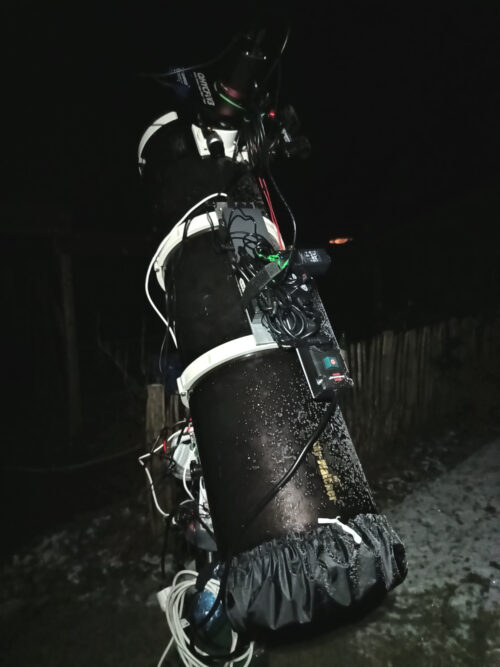
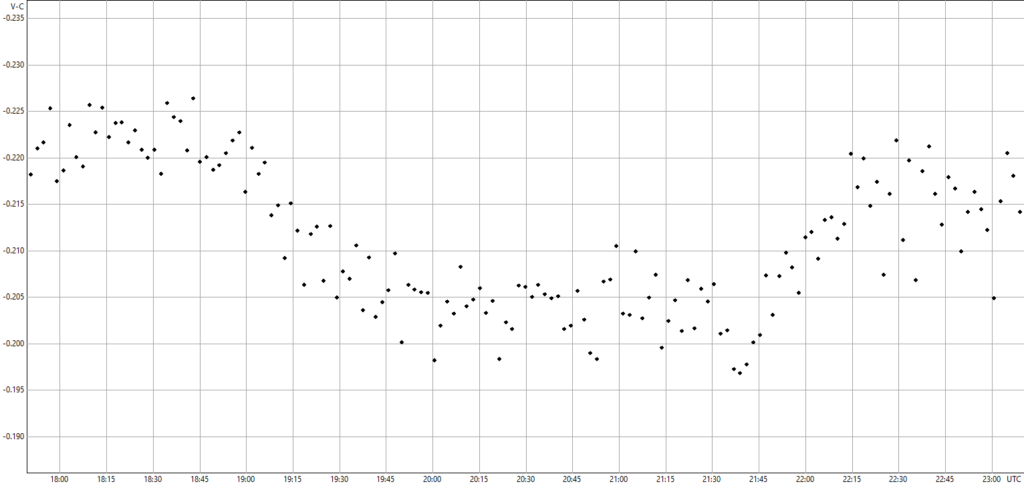
153 measuring points were recorded between 17:50 UTC and 23:09 UTC. Each image was exposed for 120 s. For the evaluation with MuniWin, 10 darks, flats and biases as well as seven comparison stars were used to normalize the recordings.
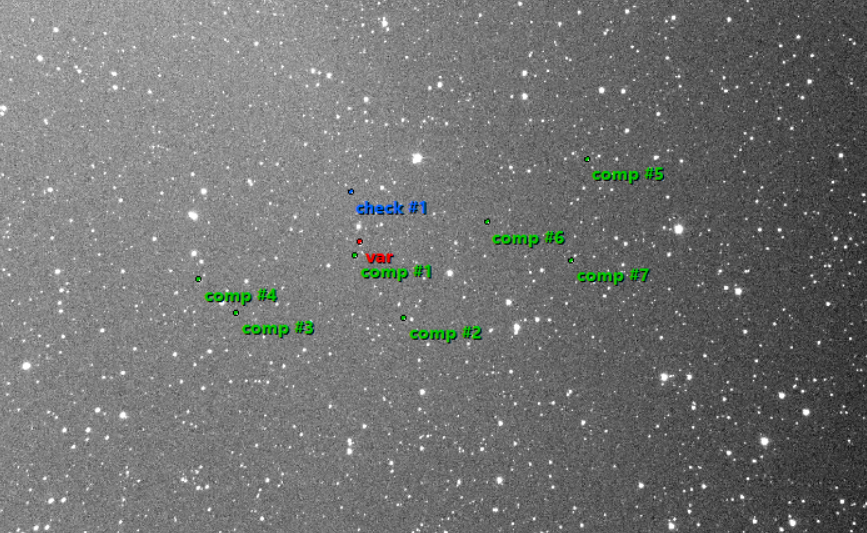
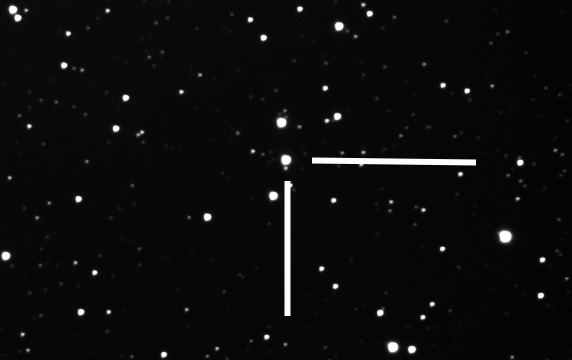
In the enlarged image of the star field you can see a “small companion” of TOI 3952. One of its names is Gaia DR3 222215976763769. However, it is anything but a neighbor. At a distance of 4540 light years, it is more than twice as far away from us as TOI 3952. Its surface temperature is 5892 K [7]. However, it could have an influence on the (aperture) photometry of TOI 3952, as it could have an influence for certain aperture diameters. But on the recordings he only manages an average count rate of around 6000, while TOI 3952 has around 620000. But at least 1%! However, it is not counted in the MuniWin photometry.
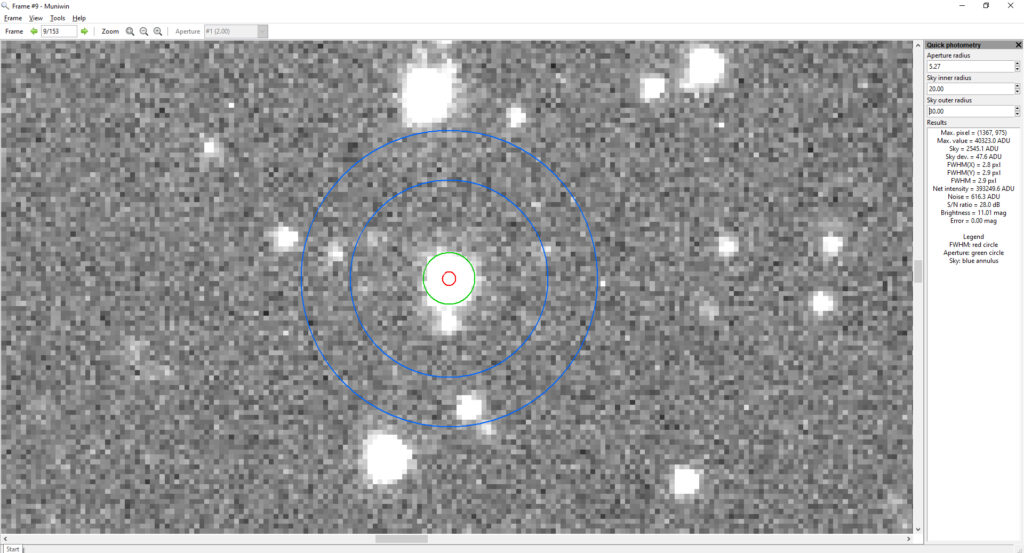
With the aperture sizes used to determine the background, weaker stars are taken into account. This has no noticeable influence on the measurement curve, as an evaluation with a narrower aperture constellation shows (see screenshot).

This “entrainment” of other stars in photometry could cause a trend if they change in brightness with a period comparable to the transit duration.
The evaluation
You can have your data automatically evaluated at the Exoplanet Transit Database (ETD), a database of the Czech Astronomical Society [5] [6]. In particular, a possible trend is calculated and removed and the resulting transit duration and depth are given.
| Source | Transit Duration (Minutes) | Transit Depth (mmag) | Transit Mid (UTC) |
| Measured values (from ETD) | 195,4 +/- 3,2 | 15,0 +/- 0,6 | 20:37 |
| ETD | 208,86 | 13,7 | 20:12 |
| Exofop | 183,36 +/- 3,54 | 14,089 +/- 0,18 | |
| Transitfinder | 184 | 12,89 | 20:35 |

The measured value for the transit duration is between the values specified by ETD or Exofop and Transitfinder. When it comes to transit depth, our own value – even taking the errors into account – is above the values of ETD and Exofop and significantly above that of Transitfinder. When determining the center of the transit there is a good agreement with the transit finder, but a strong deviation from the ETD.
Since the ETD and Exofop or Transitfinder values (ETD does not provide a source) vary greatly among themselves, one cannot yet speak of reliable literature values. The discovery is not that far behind, so further changes may arise. It remains to be seen and at the same time exciting which values will be measured by other authors.
Updated on February 15, 2024
ETD has now updated its database. Three other measurements as well as our own measurement were evaluated. These measurements do not yet show a consistent picture, so it is not yet possible to say with sufficient accuracy what the exact values of the planet are. [8]
| Measured data | ETD |
| R(Exoplanet) = 1,792 +0,035 -0,036 R(Jupiter) | R(Exoplanet) = 1,649 R(Jupiter) |
| R(star) = 1,567 R(sun) |
ETD calculated the planetary radius from the transit depth and the radius of the parent star. TOI 3952.01 (also called TOI 3952 b) is a significantly larger planet than Jupiter. ETD does not give a source for the radius of the host star. The company's own data can be found at ETD at [9].

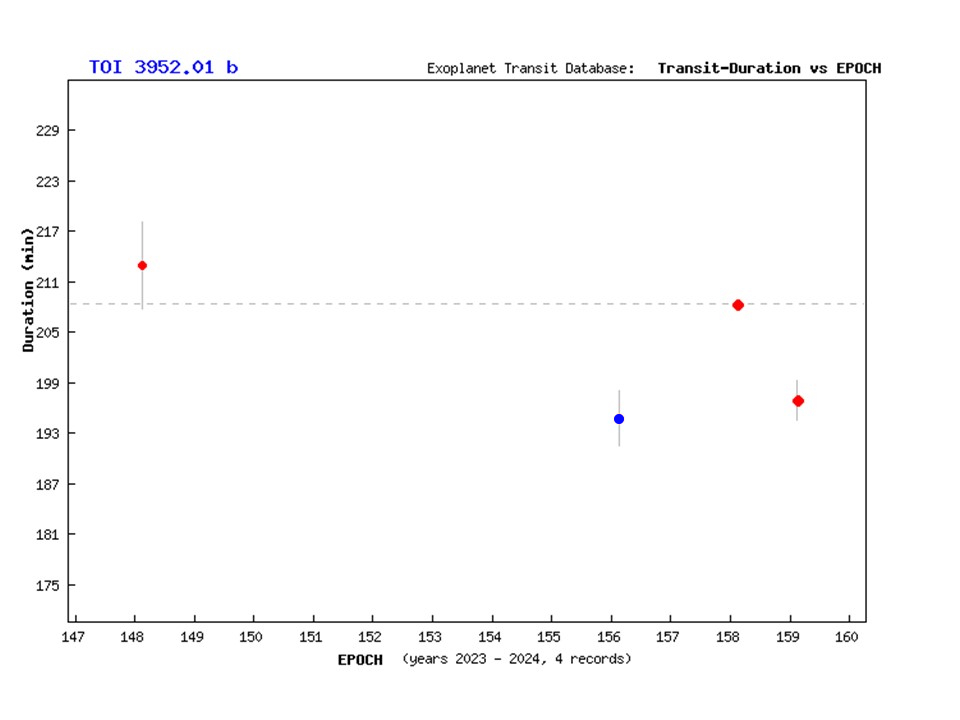
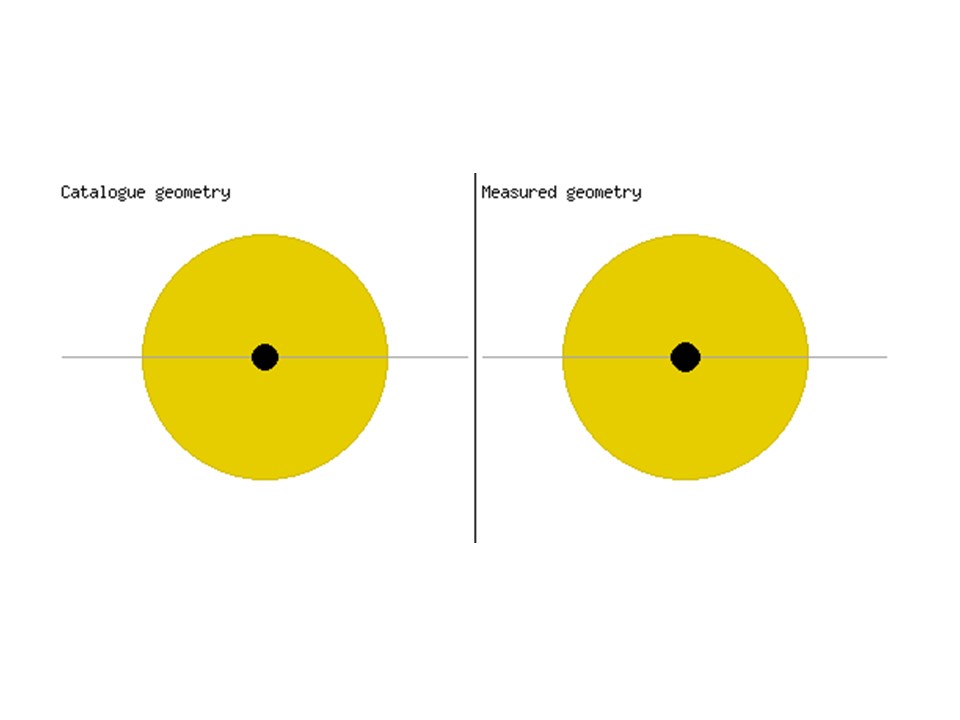
___________________________________________________________________________
[1] Guerrero et al. 2021, Guerrero, N. M., Seager, S., Huang, C. X., et al. 2021, ApJS, 254:39
[2] https://exofop.ipac.caltech.edu/tess/target.php?id=321861405
[3] https://exoplanetarchive.ipac.caltech.edu/overview/TOI%203952.01#planet_TOI-3952-01_collapsible
[4] Transitfinder is a database from Swarthmore College (https://www.swarthmore.edu) in the USA to predict exoplanet transits in front of their parent star. It was used to plan the present measurement.
[5] http://var2.astro.cz/ETD/predictions.php
[6] Poddany S., Brat L., Pejcha O., New Astronomy 15 (2010), pp. 297-301,
Exoplanet Transit Database. Reduction and processing of the photometric data of exoplanet transits (arXiv:0909.2548v1)
[7] Für diese Arbeit wurden Daten der Mission Gaia der Europäischen Weltraumorganisation (ESA) (https://www.cosmos.esa.int/gaiawwhich were edited by Gaia Data Processing and Analysis Consortium (DPAC, https://www.cosmos.esa.int/web/gaia/dpac/consortium). DPAC was funded by national institutions, particularly those participating in the Gaia Multilateral Agreement.
[8] http://var2.astro.cz/ETD/etd.php?STARNAME=TOI%203952.01&PLANET=b
[9] http://var2.astro.cz/EN/tresca/transit-detail.php?id=1705066312